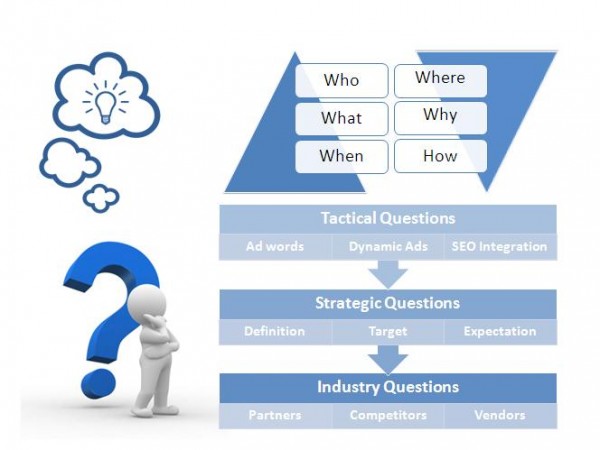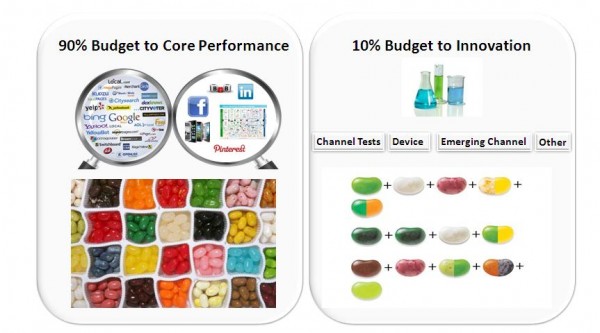Test Then Invest: Putting Innovation Into Your B2B Search Program
As we move toward the halfway point of 2012, now is a great time to ask ‘how successfully has my B2B search campaign performed?’ We still have the second half of the year to realize our goals, and for those who are on track, it is highly likely that your efforts are fueled by innovation […]
As we move toward the halfway point of 2012, now is a great time to ask ‘how successfully has my B2B search campaign performed?’ We still have the second half of the year to realize our goals, and for those who are on track, it is highly likely that your efforts are fueled by innovation in some form or fashion.
If you are not on track, you might be asking yourself, what more can I do to gain the results I need in my search program? If your efforts have focused on what has historically worked and you have reached a plateau, it is likely due to missing the opportunity to test your way to new results.
To position your campaign ahead of the competition, the one area you cannot afford to neglect is your innovation. In our lives as marketers, all too often we can get caught up in a pattern of simply endeavoring to execute ‘best practices’.
While best practices are indeed a key pillar to your program, it will merely suffice to keep you at pace with your market.
Because of this reality, and the ever evolving nature of the digital ecosystem, creating a program of innovation is a key step to ensure growth and competitive success.
Defining Innovation: A Habit Of Creating New Ways To Produce Results
So in order to make sure that we are being efficient in our approach to innovation, a definition is warranted. If we look in the dictionaries to define innovation we usually find a definition like this one from Merriam Webster: “the introduction of something new.”
That’s all well and good, but that happens in some manner every day and does not easily help us to succeed in our efforts. Innovation must be accomplished consistently and systematically and produce results, and for this reason we can simply define Innovation as a habit of creating new ways to produce results.
So what does this look like in your B2B marketing efforts? Here are three steps you can take to set up your program to foster a habit of creating new results.
Engage Challenges & Foster Systemic Curiosity
Along the way, we have all likely executed something we can safely call innovative. But what truly sets Innovative organizations apart is consistency in continually identifying new ways of thinking about untapped opportunities.
At the core of this mindset is a continual pursuit of understanding the challenges and fulfilling our curiosities. In order to achieve a paradigm of innovation, we have to remember to document and reflect on the challenges we are facing. The most amazing ideas can be sitting right in front of your screen, but they mostly arrive when you are trying to solve a problem.
As you think through the most pressing challenges facing your efforts, begin to create a matrix of what these challenges are and where they fit in your ecosystem.
Once you have the clear idea of your issues, you can begin to explore solutions. To help create an environment of curiosity, the key premise to succeed is to remember to ask the why and how of any challenges you are facing.
As an example, if you have reached a stage where the Quality Score of your ad campaigns just doesn’t seem to improve despite your best efforts, think about the reasons beyond the usual host of levers and buttons you can push in your program.
If there were no limits, what would you like to see happen? What does it take to get there?
This does not simply mean asking tactical questions that we all want answers to, such as what is the ROI and how are the KPI’s in our efforts. Rather look for ideas and inspiration everywhere.
In a similar way, document your questions and ideas as you think through solutions. If you can begin to create the habit of graphing out your needs, you are well on your way to identifying new ways of approach your efforts.
Dare To Fail: Test. Test? Test!
Now that you have your challenges and questions, every good digital marketer knows what to do next: Test your thinking.
In digital marketing, we can all count ourselves fortunate to be in an industry where measurability is at our finger tips 24/7. At no other time in marketing history can we actually see such a comprehensive footprint of the audiences we are seeking to engage, and have access to so many types of data to help us gain accurate insight into what works, and what doesn’t.
With such power in data, we are now at liberty to explore new ways of engaging with customers and prospects, and the only thing holding us back is the will to test.
Too often, I am consulting with clients who are so focused on simply producing immediate results that they can miss huge opportunities to grow. To use an analogy, they are simply concerned with where they are getting their dinner today vs. where they will get their dinner tomorrow.
The way to avoid this constant short term scramble is to implement a sacrosanct testing philosophy in your program.
To create an effective test program, you must dedicate a percentage of your time and budget to the sustained, ongoing exercise of testing. I am not simply referring to simple ad rotation tests or creative copy testing. Rather, to really looking for uniquely new ways of improving the entire marketing program.
As a start, a good idea is to look for a 90/10 split in core activities to testing activities. The tests you conduct can be as diverse as your imagination can take you, but the core mission should always be to solve the challenges you are facing and to discover new ways to produce results.
Don’t be despondent if a test fails. If you haven’t failed in your efforts, you are not trying hard enough.
Mapping Your Tests To The B2B Buyer Journey
Within the B2B marketing ecosystem we have the added complexity of long sales cycles and complex buyer journeys. Because of this, there are going to be many areas within which to test.
Depending on the immediate needs of your program, whether that is leads sales or awareness, one fruitful exercise is to map out a B2B customer journey and they create tests based on what you want to learn from each segment.
One example would be to take your current lead funnel, in this instance broken out by four different customer stages, and then frame tests to help identify where your key market segments .
While the immediate low hanging fruit is that the conversion stages, if you can identify where along the entire buyer journey your future clients are missing your campaign efforts you will be able to spotlight new ways and means of improving the conversion rate of your entire lead funnel.
Extrapolate, Learn, Share
Lastly, the best way to yield optimal results from your testing is to share, and share with everyone. Once you are able to identify and leverage some of your tests and experiments, you can extrapolate what drove the success (or failure) and learn from the effort.
We live in challenging economic times, and especially in B2B where resources are always scarce, applying the wisdom of the crowd is the most fruitful thing you can do to succeed. When you share your innovations, it gives everyone a chance to learn from what you achieved and where there are limited results.
This will benefit your efforts not only in providing a healthy feedback loop from your teams and stakeholders that will improve your cannel performance, but it also gets your constituents engaged in your efforts.
When people can see the way you have approached success, they too begin to think about how they can improve their efforts. The mindset becomes engrained in your stakeholder DNA, and soon you can find new ways of working together to improve your overall B2B Marketing Innovation.
Contributing authors are invited to create content for Search Engine Land and are chosen for their expertise and contribution to the search community. Our contributors work under the oversight of the editorial staff and contributions are checked for quality and relevance to our readers. The opinions they express are their own.
Related stories
New on Search Engine Land




